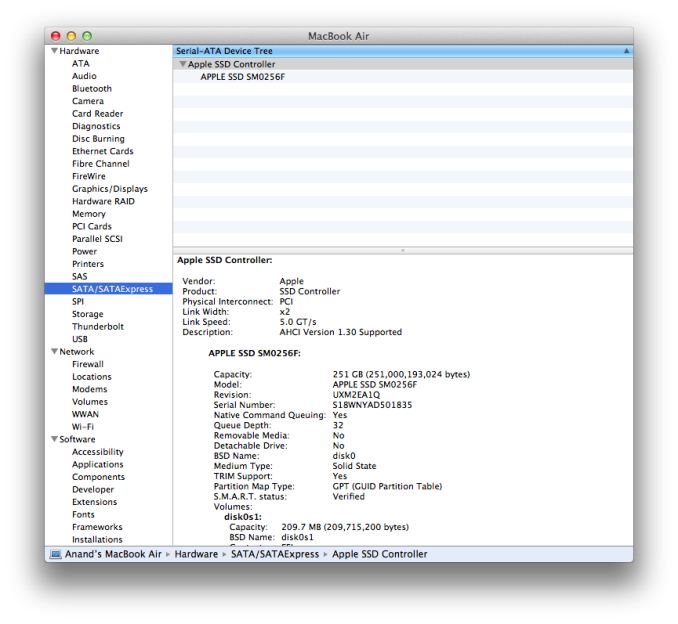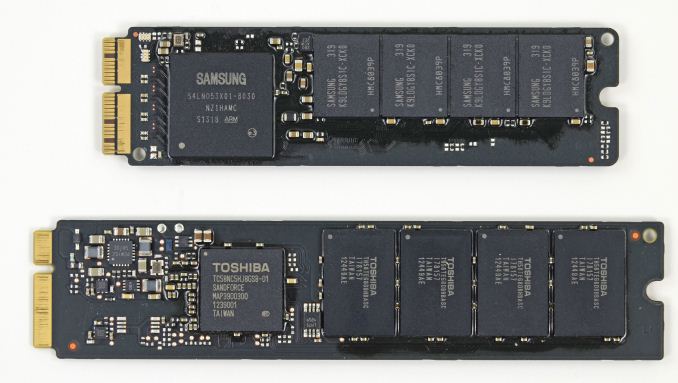The 2013 MacBook Air Review (13-inch)
by Anand Lal Shimpi on June 24, 2013 12:01 AM ESTA Custom Form Factor PCIe SSD
In the old days, increasing maximum bandwidth supported by your PATA/SATA interface was always ceremonial at first. Hard drives were rarely quick enough to need more than they were given to begin with, and only after generations of platter density increases would you see transfer rate barriers broken. Then came SSDs.
Not only do solid state drives offer amazingly low access latency, but you can hit amazingly high bandwidth figures by striping accesses across multiple NAND Flash die. A 256GB SSD can be made up of 32 independent NAND die, clustered into 8 discrete packages. A good controller will be able to have reads/writes in flight to over half of those die in parallel. The result is a setup that can quickly exceed the maximum bandwidth that SATA can offer. Today that number is roughly 500MB/s for 6Gbps SATA, which even value consumer SSDs are able to hit without trying too hard. Rather than wait for another rev of the SATA spec, SSD controller makers started eyeing native PCIe based controllers as an alternative.
You can view a traditional SSD controller as having two sides: one that talks to the array of NAND flash, and one that talks to the host system’s SATA controller. The SATA side has been limiting max sequential transfers for a while now at roughly 550MB/s. The SATA interface will talk to the host’s SATA interface, which inevitably sits on a PCIe bus. You can remove the middle man by sticking a native PCIe controller on the SSD controller. With SATA out of the way, you can now easily scale bandwidth by simply adding PCIe lanes. The first generation of consumer PCIe SSDs will use PCIe 2.0, since that’s what’s abundant/inexpensive and power efficient on modern platforms. Each PCIe lane is good for 500MB/s, bidirectional (1GB/s total). Apple’s implementation uses two PCIe 2.0 lanes, for a total of 1GB/s of bandwidth in each direction (2GB/s aggregate).
The move to a PCIe 2.0 x2 interface completely eliminates the host side bottleneck. As I pointed out in my initial look at the new MacBook Air, my review sample’s 256GB SSD had no problems delivering almost 800MB/s in peak sequential reads/writes. Do keep in mind that you’ll likely see slower results on the 128GB drive.
Users have spotted both Samsung and SanDisk based PCIe SSDs in the 2013 MacBook Airs. Thankfully Apple doesn’t occlude the controller maker too much in its drive names. An SM prefix denotes Samsung:
My review sample featured a Samsung controller. There’s very little I know about the new Samsung controller, other than it is a native PCIe solution that still leverages AHCI (this isn't NVMe). Within days of Apple launching the new MBAs, Samsung announced its first consumer PCIe SSD controller: the XP941. I can only assume the XP941 is at least somewhat related to what’s in the new MBA.
The Samsung controller is paired with a 512MB DDR3 DRAM and 8 Samsung 10nm-class (10nm - 20nm process node) MLC NAND devices.
New PCIe SSD (top) vs. 2012 MBA SATA SSD (bottom) - Courtesy iFixit
Despite moving to PCIe, Apple continues to use its own proprietary form factor and interface for the SSD. This isn’t an M.2 drive. The M.2 spec wasn’t far enough along in time for Apple to use it this generation unfortunately. The overall drive is smaller than the previous design, partially enabled by Samsung’s smaller NAND packages.












233 Comments
View All Comments
Skolde - Monday, June 24, 2013 - link
I find the current display resolutions on these "premium" products to be very lacking for me to actually seriously consider a purchase. At least stick something in there like 1600x900.....1366 x 768? Come on!
Also - bumping the memory up to 8GB would be nice. I know it isn't build to be a workhorse, but still.
The XPS13 from Dell seems to be a much nicer option currently.
rangerdavid - Monday, June 24, 2013 - link
1440 x 900 on this 13".ddriver - Monday, June 24, 2013 - link
Why not, they put higher resolution on 5 inch phones...darwinosx - Monday, June 24, 2013 - link
They put higher resolution screens on their retina laptops. The Air focus on battery life and performance above all.designerfx - Monday, June 24, 2013 - link
except that's a problem. You can't take advantage of certain basic parts of *performance* if you have a terrible display.dsumanik - Tuesday, June 25, 2013 - link
Here is the non TLDR version of this review:"intel came out with a new CPU, samsung made a new SSD and apple slapped it together last minute in an existing design. Ultimately, You get a slower, longer lasting air for a 100 bucks less that carries over all the little annoyances from last year."
whoop dee f*ckin do……..This is apple innovation?
"the m.2 spec wasnt far enough along to be used in this generation"
Oh please, What a load of horse ****. I think anand, like many other review sites invested heavily in apple stock and are now trying to stop the bleeding. Apple has been deliberately stifling user upgrades for years….That is why they have proprietary connectors…ON EVERYTHING...your readers, and your reviewer knows this.
"The only thing that hasn't changed, that perhaps should have is the display. "
ya think? My phone has better rez. You've been criticizing PC makers for 2 years about the 1366x768 resolution, and here we have apple in 2013 and you say they "perhaps should have changed"
ROFL
Here are some "cheap" things they could have done to actually make this product an upgrade:
-move the thunderbolt port beside the power connector (no more stethoscope when plugged in driving a display)
-second thunderbolt port (now you can have 2 displays native and not be down a precious USB3)
-16gb ram availability (now I can run several VM's comfortably when developing)
-performance on par with last years MBA?
-nfc support
-4G support
here is some mild innovation they could have done:
-detachable screen (tablet notebook hybrid)
-retina display
-wireless desktop charger
3rd tier PC makers are coming out with better hardware than apple now, this year was critical and they've dropped the ball…with the exception of the Mac pro.
a smartwatch *could* be cool if it comes out totally water proof for active users…jogging swimming etc, if not i don't see the incentive to purchase unless it is super low cost.
what they need to "fix" the situation
-low cost iPhone (incoming 2013)
-large screen iPhone (2014)
-retina display across the board on all products (2015)
-updated thunderbolt display, USB3 and 4k Rez for under 2000 bucks.
-apple branded TV and home theatre system
-thunderbolt or USB3 sync speeds on all iDevices
Dump your apple stock now, it will bounce back but never to the highs it was previously.
Glindon - Wednesday, June 26, 2013 - link
Bored much?abazigal - Wednesday, June 26, 2013 - link
Can you name me all the other manufacturers who are implementing these features, much less doing them properly?You want retina, there's the 13" retina MBP. And I think he was criticising manufacturers for using 1366x768 res on a 13" laptop screen. Apple uses that for their 11" MBA line, which I find is still acceptable.
Apple decided that a slight decrease in performance was an acceptable tradeoff for longer battery life. And I am inclined to agree with them. The new processor speed still more than suffices for what typical consumers use it for anyways.
What am I supposed to do with NFC on a laptop? You want the power source to be beside the thunderbolt port. I don't think there is quite sufficient space for 2 USB ports on one side, and so long as it hooks up to your thunderbolt display just fine, does it really irritate you so that the two cables split up?
Personally, I feel there is nothing Apple "needs" to do. I am perfectly fine with their products. I like them, I buy them.
ysaykin - Saturday, July 13, 2013 - link
I think that in a way the comments are right. 11 inch laptops for $1000 should have some luxury features. One of those is amazing battery life, good keyboard, nice display, and good performance. The macbook air has some bases covered, but lacks the display. The resolution is fine for a sub $600 notebook but not at $1000, also a TN panel on a $1000 notebook sounds like a rip off. It should have been at least an ips panel. The longer battery life is only achievable because Mac OSx has been optimized for battery life, but if you use windows on the machine your battery takes a huge dip. So is it a good laptop, definitely, but is it worth the $1000 price? I think it's def a mac tax. Look at the Lenovo yoga which if updated to haswell would have awesome battery life, touchscreen, ips 1600x900 resolution, and convertible to tablet mode.rudolphbyers - Thursday, October 9, 2014 - link
There's nothing that could replace my MacBook Air! /Rudolph from http://www.consumertop.com/best-laptop-guide/